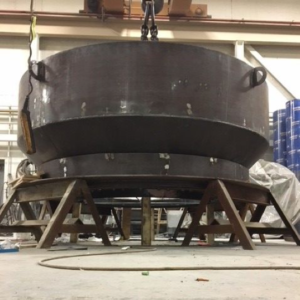In order to find the perfect refractory for every application, refractory manufacturers use a variety of different materials. By using special blends and compositions, companies like Schad are able to find custom solutions for every project and installation.
Common Refractory Materials
- Aluminum Oxide
- Silicon Oxide
- Magnesium Oxide
- Calcium Oxide
- Fireclay
- Zirconia (good very hot temperatures)
- Silicon Carbide (oxygen-free settings)
- Graphite (oxygen-free settings)
- Tungsten Carbide
- Boron Nitrate
Classification of Refractory Products
Depending on the types of materials used, refractory products typically fall into three classifications. Where they fall is dependent upon their chemical composition, method of manufacture, physical form, ways they are used, and fusion temperature.
Acidic Refractories: These products must be based on acidic materials such as alumina or silica. They are extremely resistant to acidity but easily degraded when exposed to alkali. Moreover, hydrofluoric acids, phosphoric acids, and fluorinated gasses are fatal to these products.
Neutral Refractories: These are typically made with alumina, chromia, and carbon materials. They sit on the fence of most products, so they’re able to be resistant to both acids and bases.
Basic Refractories: Products made with magnesia, dolomite, and chrome-magnesia. These products are resistant to acids.
Refractory Mortar
Refractory mortar deserves its own section. The mortar is able to fill joints and bond individual bricks together, playing a pivotal role in maintenance and installation.
Mortars generally fall into two classes:
- Heat-Setting Mortars: Require high temperatures to develop their ceramic set.
- Air-Setting Mortars: Take a firm set upon drying.
The benefits of refractory mortars are their superior workability and water retention over a wide range of consistencies. They are often used for repair on clipped or troweled joints, surface coating for walls, or patching jobs.
Monolithic Refractories
Like mortar, monolithic refractories are unique in their uses and materials. They are made with mixes or dry granular or cohesive plastic materials and used to make joint-free linings.
The reason monolithic products are so vital is that they are perfect for quick installations, avoiding delays, and forming special shapes. Monolithics play a very important role in the maintenance of refractories.
The common types of monolithic refractories one can commonly find include:
- Plastic Refractories
- Ramming Mixes
- Gunning Mixes
- Shotcretes
- Castables
Dry-Out of Refractories
Lastly, the heating up and drying out process of the refractory affects the lifespan of these products and materials. Operators must follow pre-determined curing, dry-out, and start-up procedures in order to avoid material failures and lifespan reductions.
Anchorage in Refractories
It is important to have something that holds refractory products in place. Because vertical walls and roof linings are a part of almost every installation, firm anchorage is vital.
The anchors have to be able to tolerate the same heat exposure as the refractory materials and must be able to maintain their hold under extremely high temperatures.
The two most common types of anchors include metallic anchors and ceramic anchors. The type of anchor is dictated by factors including the type of material, thickness, the shape of vessel, and application.
Aside from the types of anchors used, the placement and number of anchorage points are extremely important. This is determined based on the conditions the equipment will operate and the materials being used.
Summary
If you need any questions answered about refractory products and materials, feel free to reach out to Schad using our contact form. Schad has been in business since 1942 and is one of the nation’s leading refractory installers.